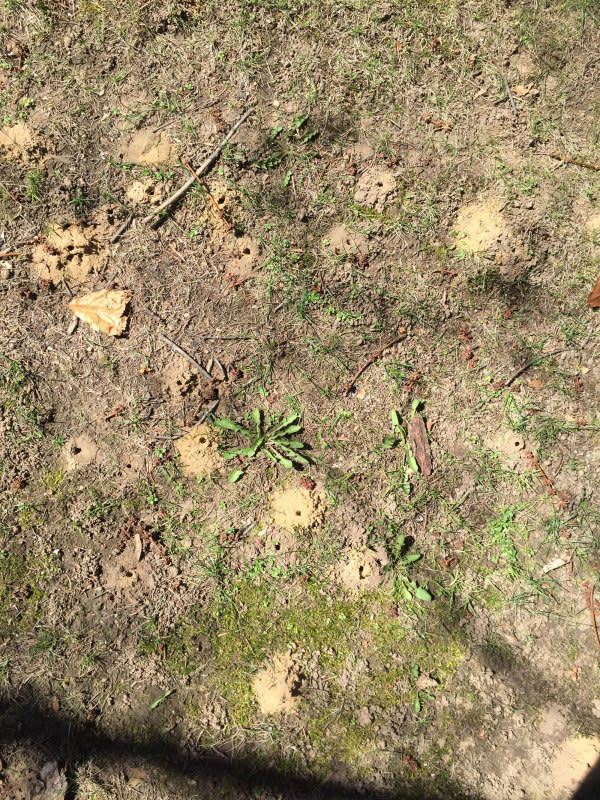Early Spring Lawn Care Tips for Every Homeowner
Spring lawn maintenance routines always feel like a phase of renewal. It demands attention and care, and while it can get frustrating that your healthy lawn doesn't appear overnight, the effort's worth it. As the seasons change, this is the ideal time to grab your rake and get busy. All the hard work that goes into your landscape those first few weeks helps to encourage air circulation in the soil, and promotes new growth and a lush, green lawn. To get more tips on getting your lawn ready, we spoke to a lawn care expert at TruGreen.
What’s the first thing you should do to care for your lawn when the snow melts?
"Get raking! Believe it or not, as soon as the snow starts melting and spring is in the air, you should start raking fallen leaves, sticks, twigs and other debris from winter," shares Dr. Roger May, TruGreen’s director of technical operations. "Roughing up matted grass and thatch layer with a rake will also improve air circulation and stimulate new healthy growth as the soils begin to warm from the longer daylight."
Once the threats of harsh winter weather have passed in the late spring, consider slow-release lawn fertilizer applications and grass seed for your lawn care routine.
When should you mow your lawn for the first time?
"Once the debris has been cleared away after the winter season, it’s time to break out the mower. Lower the lawn mower blades for a closer cut that first run," advises May. "This will remove dead grass blades, help to improve air circulation, promote strong roots, and stimulate new grass growth."
Other techniques that help include:
Avoid mowing wet grass. It can lead to compacted soil.
Alternate mowing patterns to prevent soil compaction and promote even growth.
Leave grass clippings on the lawn to provide natural nutrients as they decompose. Lawn clippings contribute to organic matter.
Related: How to Grow Grass in a Shaded, Mossy Yard
What are some common spring lawn pests and how can I control them?
The pests you're most likely to experience in your lawn during the spring include grubs, chinch bugs, armyworms, and aphids. There isn't a one-size-fits-all solution for these critters, but these tips should help:
Grubs
Grubs are larvae of various beetles and can damage grass roots, leading to dead spots in your lawn.
Using biological (natural) control agents like nematodes to manage grubs is effective. These nematodes seek out and parasitize grubs, ultimately killing them. Mix them with water according to the package instructions and apply evenly over the affected lawn areas using a sprayer. It's crucial to water the lawn before and after application to ensure the soil is moist, allowing the nematodes to move freely and reach the grubs.

Emily Fazio
Chinch Bugs
Chinch bugs are small insects that suck sap from grass, causing yellowing and eventually killing the turf.
Insecticides containing active ingredients like bifenthrin or carbaryl can effectively control their populations, but follow the instructions carefully. Spraying the insecticide during calm weather when there's no breeze is important. Also, avoid spraying when bees or other beneficial insects are active.
Armyworms
Armyworms are voracious caterpillars that can quickly strip grass blades, causing extensive damage to lawns.
Insecticides with spinosad or permethrin, can be used to control the infestation. Similar to chinch bugs, follow the instructions on the insecticide label for proper mixing and application. Apply the insecticide evenly over the affected lawn areas, focusing on areas where armyworm activity is observed.
Aphids
These small, soft-bodied insects feed on plant sap, causing distortion and stunting plant growth. Natural predators like ladybugs are highly effective in controlling aphid populations. Welcome those natural predators to your property by planting flowers such as dill, fennel, or marigolds that attract them. You can also purchase ladybugs and release them onto your lawn.
When should I start watering my lawn in the spring?
In the spring, commit to a regular watering schedule as soon as the soil starts drying out and the grass seems stressed. Opt for early mornings to water, reducing evaporation and the risk of fungal growth. Make sure to water deeply but infrequently. Overwatering is a common issue, especially if you have soil drainage issues. Get the soil moistened to a depth of 6 to 8 inches to satisfy deeper roots, then aim for around 1 to 2 inches of water per week, factoring in any rainfall.
